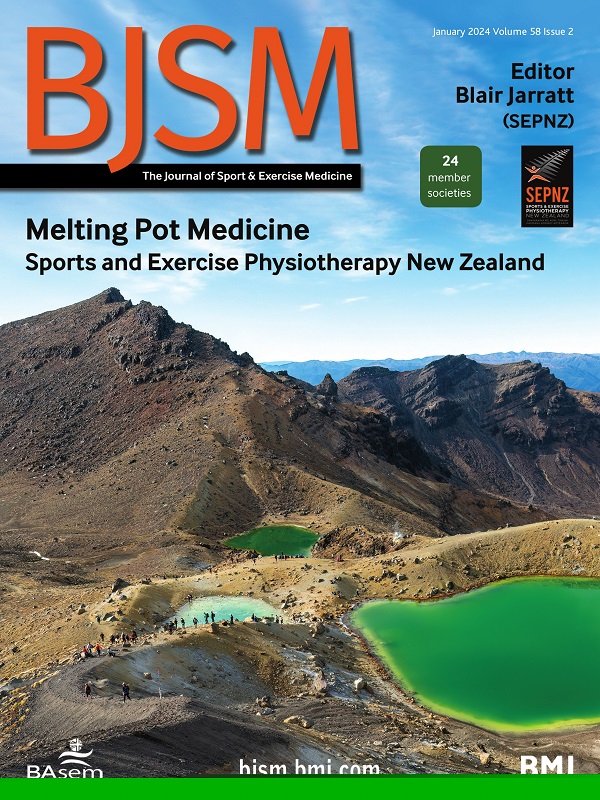Sleep quantity and quality during the first week postinjury and time to symptom resolution in youth with concussion
IF 11.6
1区 医学
Q1 SPORT SCIENCES
引用次数: 0
Abstract
Objective To examine bidirectional associations between objective measures of sleep quantity and quality with postconcussion symptoms (PCS) scores in concussed youth during the first week postinjury and to explore the associations between sleep measures and time to symptom resolution. Study design We conducted a secondary analysis of a prospectively enrolled cohort of youth (11–17 years) with a physician diagnosed concussion within 72 hours of injury. During the first week postconcussion, sleep quantity (time in bed, total sleep time and daytime sleep) and sleep quality (sleep efficiency, WASO and number of awakenings) were measured using an ActiGraph. We evaluated bidirectional temporal associations between the sleep measures and PCS during the first week postinjury using cross-lagged panel models. We assessed the associations between sleep measures and time to symptom resolution using Cox proportional hazard models. Results Participants included 78 concussed youth, 34.6% females, mean age of 14.2 years (SD=2.1). Significant bidirectional associations were observed between PCS and both total sleep time and daytime total sleep in the first week postinjury. Increased daytime sleep was also associated with a decreased likelihood of symptom resolution, adjusted HR (aHR)=0.88, 95% CI=0.78, 0.999. An optimal total sleep time of 418 min per day was associated with a 2.1-fold increased likelihood of symptom resolution (aHR=2.1, 95% CI=1.3, 3.2). Conclusions Clinicians should provide guidance on sleep hygiene, including limiting daytime sleep/naps and getting the appropriate amount of nighttime sleep acutely postconcussion to aid recovery in youth. Data are available upon reasonable request. Dr Yang has full access to all of the study data and takes responsibility for the integrity of the data and the accuracy of the data analysis. The data sets generated and/or analysed during the current study are available from Dr Yang upon reasonable request. Raw data are not available due to parameters indicated in the participant consent materials.青少年脑震荡患者伤后第一周睡眠时间和质量与症状缓解时间的关系
目的探讨青少年脑震荡后1周内客观睡眠量和质量测量与脑震荡后症状(PCS)评分的双向关系,并探讨睡眠测量与症状缓解时间的关系。研究设计:我们对一组在受伤后72小时内被医生诊断为脑震荡的青年(11-17岁)进行了二次分析。在脑震荡后的第一周,使用ActiGraph测量睡眠量(床上时间、总睡眠时间和白天睡眠时间)和睡眠质量(睡眠效率、WASO和醒来次数)。我们使用交叉滞后面板模型评估了损伤后第一周睡眠测量和PCS之间的双向时间关联。我们使用Cox比例风险模型评估了睡眠测量和时间与症状缓解之间的关系。结果青年脑震荡患者78例,女性34.6%,平均年龄14.2岁(SD=2.1)。损伤后第一周,PCS与总睡眠时间和白天总睡眠时间存在显著的双向关联。白天睡眠增加也与症状缓解的可能性降低相关,调整HR (aHR)=0.88, 95% CI=0.78, 0.999。每天418分钟的最佳总睡眠时间与症状缓解的可能性增加2.1倍相关(aHR=2.1, 95% CI=1.3, 3.2)。结论临床医生应提供睡眠卫生指导,包括限制白天睡眠/小睡和获得适当的夜间睡眠,以帮助青少年脑震荡后急性康复。如有合理要求,可提供资料。杨博士拥有所有研究数据的完全访问权,并对数据的完整性和数据分析的准确性负责。在本研究中产生和/或分析的数据集可应杨博士的合理要求提供。由于参与者同意材料中的参数,原始数据不可用。
本文章由计算机程序翻译,如有差异,请以英文原文为准。
求助全文
约1分钟内获得全文
求助全文
来源期刊
CiteScore
27.10
自引率
4.90%
发文量
217
审稿时长
3-8 weeks
期刊介绍:
The British Journal of Sports Medicine (BJSM) is a dynamic platform that presents groundbreaking research, thought-provoking reviews, and meaningful discussions on sport and exercise medicine. Our focus encompasses various clinically-relevant aspects such as physiotherapy, physical therapy, and rehabilitation. With an aim to foster innovation, education, and knowledge translation, we strive to bridge the gap between research and practical implementation in the field. Our multi-media approach, including web, print, video, and audio resources, along with our active presence on social media, connects a global community of healthcare professionals dedicated to treating active individuals.

 求助内容:
求助内容: 应助结果提醒方式:
应助结果提醒方式:


